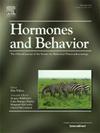Corticosterone predicts double-brooding in female savannah sparrows (Passerculus sandwichensis)
IF 2.4
3区 医学
Q2 BEHAVIORAL SCIENCES
引用次数: 0
Abstract
Given that double-brooding (rearing two broods within a season) can increase annual fecundity, it is unclear why some females in multi-brooded populations rear only one brood per season. The Quality Hypothesis proposes that double-brooded females are high quality and, thus, have sufficient energetic resources available to bear the costs of rearing two broods per season. Glucocorticoids — endocrine hormones that have a critical role in energy regulation — could reflect female quality, and, therefore, also have the potential to indicate whether a female will rear a second brood. Using 12 years of reproductive data on migratory Savannah sparrows (Passerculus sandwichensis) from a population in eastern Canada, we explored whether baseline corticosterone concentrations were correlated with measures of female quality (body condition and fat score) and whether a female's baseline corticosterone concentrations during her first brood would predict whether she attempted a second. We found weak evidence that baseline corticosterone was negatively correlated with female body condition and found strong evidence that baseline corticosterone was negatively correlated with fat score. There was weak evidence for a positive relationship between double-brooding and baseline corticosterone in females sampled during the first brood incubation stage. Additionally, there was moderate evidence to suggest that the probability of double-brooding was negatively related to baseline corticosterone in females sampled during the first brood nestling stage. Our results provide evidence that corticosterone can reflect female condition in the context of double-brooding and demonstrate the importance of considering breeding stage when assessing corticosterone concentrations in parents.
皮质酮预测雌性草原麻雀(雀鸟)的双育。
考虑到双育(在一个季节内养育两个后代)可以增加年繁殖力,目前尚不清楚为什么在多育种群中有些雌性每个季节只养育一个后代。质量假说认为,双育的雌性质量高,因此有足够的能量资源来承担每个季节养育两个后代的成本。糖皮质激素——一种在能量调节中起关键作用的内分泌激素——可以反映出雌性的质量,因此,也有可能表明雌性是否会养育第二窝。利用加拿大东部迁徙萨凡纳麻雀(Passerculus sanhensis)种群12年的生殖数据,我们探讨了基线皮质酮浓度是否与雌性质量(身体状况和脂肪评分)的测量相关,以及雌性在第一次产卵期间的基线皮质酮浓度是否会预测她是否会尝试第二胎。我们发现基线皮质酮与女性身体状况呈负相关的证据不足,而发现基线皮质酮与脂肪评分呈负相关的证据不足。有微弱的证据表明,在第一窝孵化阶段的雌性样本中,双育与基线皮质酮呈正相关。此外,有中度证据表明,在第一窝雏鸟阶段取样的雌性双育概率与基线皮质酮呈负相关。我们的研究结果证明,皮质酮可以反映双育背景下雌性的状况,并表明在评估父母体内皮质酮浓度时考虑繁殖阶段的重要性。
本文章由计算机程序翻译,如有差异,请以英文原文为准。
求助全文
约1分钟内获得全文
求助全文
来源期刊

Hormones and Behavior
医学-行为科学
CiteScore
6.70
自引率
8.60%
发文量
139
审稿时长
91 days
期刊介绍:
Hormones and Behavior publishes original research articles, reviews and special issues concerning hormone-brain-behavior relationships, broadly defined. The journal''s scope ranges from laboratory and field studies concerning neuroendocrine as well as endocrine mechanisms controlling the development or adult expression of behavior to studies concerning the environmental control and evolutionary significance of hormone-behavior relationships. The journal welcomes studies conducted on species ranging from invertebrates to mammals, including humans.
 求助内容:
求助内容: 应助结果提醒方式:
应助结果提醒方式:


